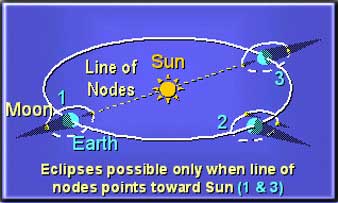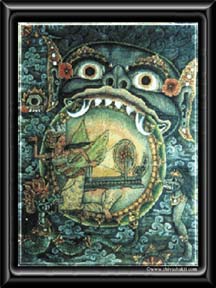 
Aspects of Nodes
There are many controversial topics within the jyotish community today...I
daresay this has always been the case and not unique to our time. The
correct/incorrect ayanamsha (as discussed in previous article) pales
into insignificance beside the hotly debated question of nodal aspects.
Sage Parashara, the father of Vedic astrology, is quite specific about
the planet's aspects but nowhere does he attribute any aspects to the
nodes...see table: Planet & Aspects The reason for this is very simple and it's due (primarily) to the
physical nature of the planets. A planet casts, or throws, it's aspect/influence
as do all physical objects in the universe. The nodes however, having
no physical body, are incapable of casting any aspect. Their influence,
according to the wise sages, as well as the laws of nature, are confined
to their own (mathematical) position...this, after all, is all that
they are ...a mathematical point on the ecliptic where the Moon intersects
as it orbits the earth.  Since the plane of the Moon's orbit is tilted at an angle to the earth's
orbit, the planes intersect at a line, called the line of nodes. The
node where the two intersect as the Moon is crossing the earth's orbit
travelling northward is called the ascending, or north, node. The opposite
node is the descending, or south, node. Any planet conjunct (either) point at birth is greatly influenced by
this phenomena...an eclipse, for instance, occurs when either Sun or
Moon is conjunct a node. Without a doubt they do have a very strong
and specific influence on the planets they conjoin and, because of this,
they're treated as planets in Vedic astrology, however, as they have
no physical body, they're known as the shadowy planets and their influence
is confined to the house they occupy, the planet(s) they conjoin and
their dispositor (the planet who's house they occupy). The north node (Rahu) is compulsive and extroverted by nature and will
draw us compulsively towards the significations of the planet he conjoins
and the affairs of the house he occupies. Rahu draws us to the things
of the world and in the 10th house, for instance, can indicate great
fame. The south node (Ketu) is diametrically opposite in nature; shy,
introverted and restrictive. His influence is to detach us from the
significations of the planet he conjoins and the affairs of the house
he occupies. Because of this quality of non-attachment Ketu is known
as Moksha Karaka...moksha means enlightenment and karaka means significator,
therefore, Ketu is the significator of enlightenment. Mythology: According to Hindu mythology the nodes are the two halves of
a rakshasa (demon) who concealed himself in the midst of the planetary
beings when they drank the amrita of immortality distributed by Lord
Vishnu. He was discovered by the luminaries (Sun & Moon) only after
he'd drank of the nectar, thereby becoming immortal (along with the
other divine planets) with the ability to manifest each time a being
is born. Upon his discovery Lord Vishnu immediately severed the demons
head with his chakra. The head became Rahu and the bottom half became
Ketu (the headless trunk). 
A rakshasa (in general) is a type of demon who has the power to change into any form including animals, dragons, monsters or, in the case of a female (rakshasi), into a beautiful woman. In this way the rakshasa, who was to become Rahu and Ketu, concealed himself amidst the planetary beings. Frequency of Eclipses (sourced from flycapers.com): As the Moon orbits the Earth, the Sun, Earth and Moon approximately line up about every 29.5 days. At this time the Moon is either at New Phase (when the Moon is between the Earth and Sun) or Full Phase (when the Earth is between the Moon and Sun). However, the Moon usually does not pass in front of the Sun (causing a solar eclipse), nor does the Moon pass into the Earth's shadow (causing a lunar eclipse) since the Moon's orbit is inclined about 5 degree to the plane of the Earth's orbit around the Sun. Solar and lunar eclipses can only occur when the Moon is near (±18¡) one of the two points where the Moon's and Earth's orbits cross (called nodes). This allows the Moon to pass at least partially in front of the Sun (a solar eclipse), or at least partially move into the Earth's shadow (a lunar eclipse). That is, for eclipses to occur the Moon must be at New or Full Phase and the line of nodes must point toward Sun (as in points 1 or 3 below). Otherwise the Moon will not lie in the plane of the Earth's orbit and eclipses will not be possible (such as point 2). Lunar Nodes and Eclipses: The Moon's orbit is inclined about 5¡ to the plane of the Earth's orbit around the Sun. Every six months the nodes line up with the Sun's direction and solar eclipses become possible at the time of New Moon. Likewise lunar eclipses become possible at the time of Full Moon. These two intervals of time when solar and lunar eclipses are possible are called eclipse seasons. Because the Moon's orbit slowly rotates in space, the nodes regress slowly with a period of approximately 18.6 causing the two eclipse seasons to occur about 19 days earlier each year. Wendy Vasicek, PGA http://www.p-g-a.org/PGA-journal-2002.html
<<<PGA DIRECTORY & JOURNAL 2002 The 9 Gems Gemstone Conflicts PG Articles <<<Check for UPDATES Planets & Gems Sidereal Astrology The PGs Dictionary PGA Patrons & Members PG Reference Material <<<IMPORTANT ADDITIONS Planetary Gemology Service Providers (The WWW's largest listing) <<<over 100 A Contemporary International View of Planetary Gemology Featured Talismans <<<Please contribute your PICS and promote your work for FREE >>>Return to PGAs HomePage The Sanskrit name for the PGA was composed by HONORARY PATRON Prof. Dr. Satya Vrat Shastri, Padma Sri |
 by Wendy Vasicek, PGA
by Wendy Vasicek, PGA